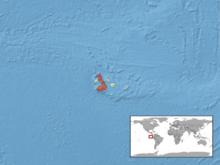Conolophus marthae
| Galápagos pink land iguana [1] | |
|---|---|
 | |
| Scientific classification | |
| Kingdom: | Animalia |
| Phylum: | Chordata |
| Subphylum: | Vertebrata |
| Class: | Reptilia |
| Order: | Squamata |
| Suborder: | Sauria |
| Infraorder: | Iguania |
| Family: | Iguanidae |
| Genus: | Conolophus |
| Species: | C. marthae |
| Binomial name | |
| Conolophus marthae Gentile & Snell, 2009[1] | |
 | |
Conolophus marthae, the Galápagos pink land iguana, is a species of lizard of the Iguanidae family. It is native only to northern Isabela Island of the Galápagos. The iguana has a pink body with some dark stripes, prompting some to call it a pink iguana or the Galapagos rosy iguana. The species was first discovered in 1986 and was identified as a separate species, distinct from the Galapagos land iguana, early in 2009.[3] This species is the only evidence of ancient diversification along the Galápagos land iguana lineage and documents one of the oldest events of divergence ever recorded in the Galápagos.[4]
Taxonomy and etymology
The generic name, Conolophus, is derived from two Greek words: conos (κώνος) meaning "spiny" and lophos (λοφος) meaning "crest" or "plume," denoting the spiny crests along their backs.
A tentative specific name, rosada, was derived from the Spanish word meaning "pink" in reference to the animal's pinkish body color. The term was later abandoned for the formal description; and the specific epithet, marthae, was chosen in memory of Martha Rebecca Gentile, the stillborn daughter of the describer Gabriele Gentile.[1][5]
The species was first formally described in early 2009 as being distinct from the other island iguana populations. Genetic analysis of the pink morph subpopulation resulted in an identification of a genetically distinct and isolated population totally different from the other iguana species on the island. Further analysis suggested that this particular species diverged from its ancestral stock some 5.7 million years past.[6][7]
Anatomy

Conolophus marthae is anatomically similar to the closely related species, Conolophus subcristatus. Both exemplify the typical saurian body shape, having squat, quadrupedal bodies with elongated tails. The legs sprawl out to the sides like all lizards, and a row of short spines runs down the middle of the lizard's back starting from the base of the neck to the tail. However, there are a few anatomical differences between the two species. The crest of C. marthae has been described as somewhat different from that of C. subcristatus. The most apparent difference is that of coloration – the body of C. marthae is pinkish with a few wide, vertical dark bands. This is a stark contrast from the yellow-brown coloration of C. subcristatus.[6]
Part of the Galapagos land iguana clade, individuals of the species first came into the public light in 1986 when park rangers spotted some pink lizards on a local volcano on Isabela Island. The entire range of the species is limited to Volcán Wolf on that particular island, and nowhere else in the Galapagos archipelago. No more than a hundred individuals have been estimated to form the single population of C. marthae.[6] Although a formal review has not been performed on the population's status, it has been suggested it should be considered a critically endangered species.[6]
References
| Wikimedia Commons has media related to Conolophus marthae. |
- 1 2 3 Gentile, Gabriele; Snell, Howard L. (2009). "Conolophus marthae sp.nov. (Squamata, Iguanidae), a new species of land iguana from the Galápagos archipelago" (PDF). Zootaxa. 2201: 1–10.
- ↑ Gentile, G. (2012). "Conolophus marthae". IUCN Red List of Threatened Species. Version 2012.1. International Union for Conservation of Nature. Retrieved 21 August 2012.
- ↑ "New Galapagos species identified". Scientific American. 2009-01-07. Retrieved 2009-01-07.
- ↑ Gentile, Gabriele; Anna Fabiani; Cruz Marquez; Howard L. Snell; Heidi M. Snell; Washington Tapia; Valerio Sbordonia (2009). "An overlooked pink species of land iguana in the Galapagos". Proceedings of the National Academy of Sciences of the United States of America. National Academy of Sciences of the United States of America. 106 (2): 507–11. doi:10.1073/pnas.0806339106. PMC 2626733
 . PMID 19124773.
. PMID 19124773. - ↑ Beolens B, Watkins M, Grayson M (2014). The Eponym Dictionary of Reptiles. Baltimore: Johns Hopkins University Press. xiii + 296 pp. ISBN 978-1-4214-0135-5. (Conolophus marthae, p. 169).
- 1 2 3 4 Black, Richard (2009-01-07). "Pink iguana rewrites family tree". BBC News. BBC. Retrieved 2009-01-07.
- ↑ Madrigal, Alexis (2009-01-05). "Pink Iguana That Darwin Missed Holds Evolutionary Surprise". Wired Science. Wired. Retrieved 2009-01-06.
